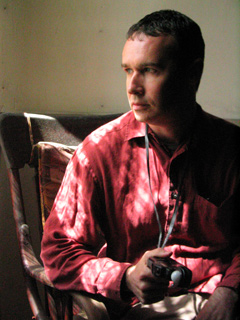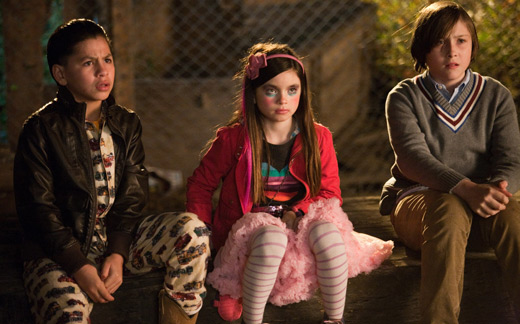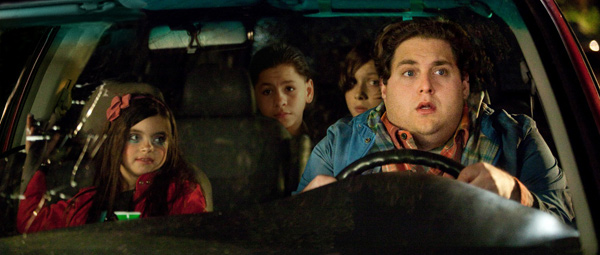Working with Kids, Driving at Night, and Making Comedy Look Natural
“We try to have fun with it while breaking certain conventions in the studio comedy genre,” says Orr. “We take a looser approach while maintaining a more naturalistic tone and look. At the same time, a Hollywood comedy comes with certain expectations. So it’s a balancing act.”

Cinematographer Tim Orr
The story demanded a lot of night work and extensive car scenes, and Orr and Green captured the action, as they always have, on film. “We felt like film would offer the right texture and deliver the best image,” says Orr. “We felt that the 1.85:1 aspect ratio was the right choice because of the car work, the group shots with Jonah and the kids, and the urban settings. With the improvisational approach, we knew that 3-perf would help us keep rolling.”
Orr shot the entire movie on KODAK VISION3 500T Color Negative Film 5219. The cameras were Panavision – a Platinum model for the A camera and an XL-2 for the B camera – with Primo lenses. The 10-week, 50-day shoot took place mostly on practical locations around New York City. Complicating matters was the fact that the children in the cast had restrictions that prevented them from working past 10 p.m. The crew settled into split days, where they worked on scenes with kids first and then moved on to wider shots in which doubles could be used.
“We started shooting the closer, dialog shots first, and the wider shots last, which is the opposite of how it’s normally done,” explains Orr. “I found this to be a bit more efficient, particularly with this style of comedy with so much improvisation. The actors don’t get burned out and they can find their performance in a tighter framing, which is helpful. Also, I find that doing the wide shots first sometimes leads the crew to take a little too much time than is necessary for a shot that will only play for a few seconds at the head or tail of a scene.”

Orr balanced the comedic aspects of the R-rated movie with moments of danger and fear. “There are certain expectations in terms of a commercial look that you can’t betray,” he says. “Still, we had to try and make certain scenes, like those in the drug dealer’s strange, creepy lair and the less-inviting city exteriors, feel grittier and more foreboding.”
Rather than making the image darker, Orr achieved that sense of foreboding in part using color temperature. “You still need images that are bright enough that you know what kind of movie you are watching,” he says. “Rather than contrast, I used dirtier colors. Usually in exterior situations, the actors were lit with a very warm, cleaner sodium-vapor-motivated street-light source with no green in it. Then in the background, and in their surroundings, I would use uncorrected cool whites in many different pockets, and in some places really strong, industrial colors in pools, like overly blue and overly green mercury vapor sources, and very saturated and dirty reds with a lot of green in them. That kept it vibrant, and made things a bit more messed up than your standard Hollywood comedy.”
Strangers on a Merry-Go-Round
A climactic sequence is set on a carousel, a la Hitchcock’s Strangers on a Train. Orr says it was easily the most challenging portion of the film to shoot. The chase scene evolves into a fight between Hill’s character and the drug dealer (Sam Rockwell), and it required some ingenuity.
“We shot at an actual carousel in Queens, but shooting practically on a moving carousel is very difficult,” says Orr. “For one thing, it can make the actors and the crew feel a bit sick after a few takes. We shot just a few pieces of actors jumping on and off, and captured some background plates for compositing, and did the majority of the sequence on stage using green-screen techniques.”
About a third of the carousel was recreated on stages in Greenpoint, Brooklyn, and surrounded by a green-screen cyclorama. The horses moved up and down, but it was up to Orr to create the illusion of a whirling ride.
“Steve Ramsey, the gaffer, and I hung long rows of wooden batten strips mounted with incandescent bulbs in the ceiling,” says Orr. “These were put on a flicker chase. That gave us a much more vibrant and carnival-esque atmosphere, but we were still missing moving shadows. We put up about 20 ceiling fans and fed them reduced voltage so they would turn at a very slow rate. That did the trick.”
They Drive By Night
The extensive driving sequences also required cinematic legerdemain, since driving around the city at night would have been impossible with the children’s schedule. Orr shot the background plates beforehand, which allowed him to tailor his process shots to match their surroundings.
“The action takes place in so many different areas of New York City, including the jewelry district, Chinatown, and Brooklyn,” says Orr. “That meant there was a wide range of color temperatures they’d be passing through. On our process stage, we had a long row of 1Ks programmed on a chase. These were gelled very warm to mimic sodium vapor. We’d change the speed of the chase depending on whether they were on a highway or a city street. Eight-foot Kino bulbs depicted storefronts. We used a random mix of really wild colors, and occasionally dropped out the fill light. Sometimes we’d have ten different crew members, each with a different kind of light in their hands, or a flag, or operating a dimmer.”
Technicolor handled the 2K digital intermediate, where Orr fine-tuned his images with the help of colorist Tim Stipan, maintaining the authentic look he strove for during production. “We wanted real and believable characters without excessive gloss or artifice,” Orr says. “Hopefully the comedy is even funnier as a result.”
Did you enjoy this article? Sign up to receive the StudioDaily Fix eletter containing the latest stories, including news, videos, interviews, reviews and more.










Leave a Reply